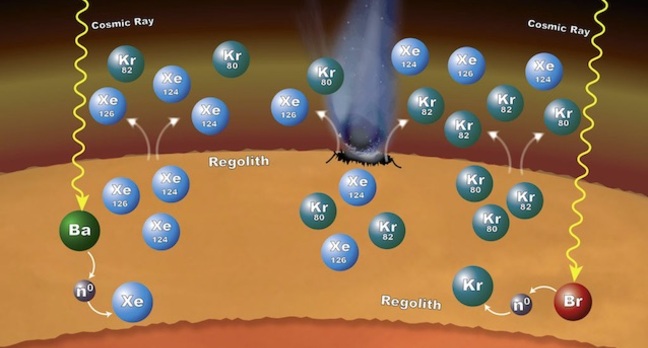
Nuclear-powered laser space tank loves the smell of exotic nenon isotopes in the morning
Cosmic rays may be bonking neutrons off barium to cook the xenon in Mars' atmosphere. Image: NASA
30 Sep 2016 at 06:42, Simon Sharwood
Mars' atmosphere is wafting up from its cold, dead soil, according to new findings from the Curiosity Rover.
A new paper titled In situ measurement of atmospheric krypton and xenon on Mars with Mars Science Laboratory explains that this story starts with the Viking landers, which recorded “krypton and xenon detections and measurements of noble gas isotope ratios in martian meteorites.”
Curiosity's got rather better kit on board than Viking. In particular there's the Sample Analysis at Mars (SAM) instrument suite that's sniffed the martian atmosphere to figure out how much krypton and xenon is wafting about.
That analysis, NASA explains, found “isotope ratios … a bit different than expected.” Specifically, SAM found “higher-than-expected levels of the isotopes xenon-124 and 126” and “unusual levels of krypton-80 and krypton-82.”
NASA explains it's possible for those isotopes to form when “neutrons … transferred from one chemical element to another within the surface material on Mars.” Neutron transfer may be the result of cosmic rays reaching into Mars' soil.
The paper conjectures that barium may have shed some neutrons that attached themselves to xenon to produce to unusual isotopes. Xenon “could have been released into the atmosphere by impacts on the surface and by gas escaping from the regolith, which is the soil and broken rocks of the surface.”
These findings are thought to hint at hypothesis whereby Mars' atmosphere is a product of the stuff wafting up from its soil and rocks, rather than solely an artefact of the processes causing the atmosphere to dissipate. ®
30 Sep 2016 at 06:42, Simon Sharwood
Mars' atmosphere is wafting up from its cold, dead soil, according to new findings from the Curiosity Rover.
A new paper titled In situ measurement of atmospheric krypton and xenon on Mars with Mars Science Laboratory explains that this story starts with the Viking landers, which recorded “krypton and xenon detections and measurements of noble gas isotope ratios in martian meteorites.”
Curiosity's got rather better kit on board than Viking. In particular there's the Sample Analysis at Mars (SAM) instrument suite that's sniffed the martian atmosphere to figure out how much krypton and xenon is wafting about.
That analysis, NASA explains, found “isotope ratios … a bit different than expected.” Specifically, SAM found “higher-than-expected levels of the isotopes xenon-124 and 126” and “unusual levels of krypton-80 and krypton-82.”
NASA explains it's possible for those isotopes to form when “neutrons … transferred from one chemical element to another within the surface material on Mars.” Neutron transfer may be the result of cosmic rays reaching into Mars' soil.
The paper conjectures that barium may have shed some neutrons that attached themselves to xenon to produce to unusual isotopes. Xenon “could have been released into the atmosphere by impacts on the surface and by gas escaping from the regolith, which is the soil and broken rocks of the surface.”
These findings are thought to hint at hypothesis whereby Mars' atmosphere is a product of the stuff wafting up from its soil and rocks, rather than solely an artefact of the processes causing the atmosphere to dissipate. ®

No comments:
Post a Comment